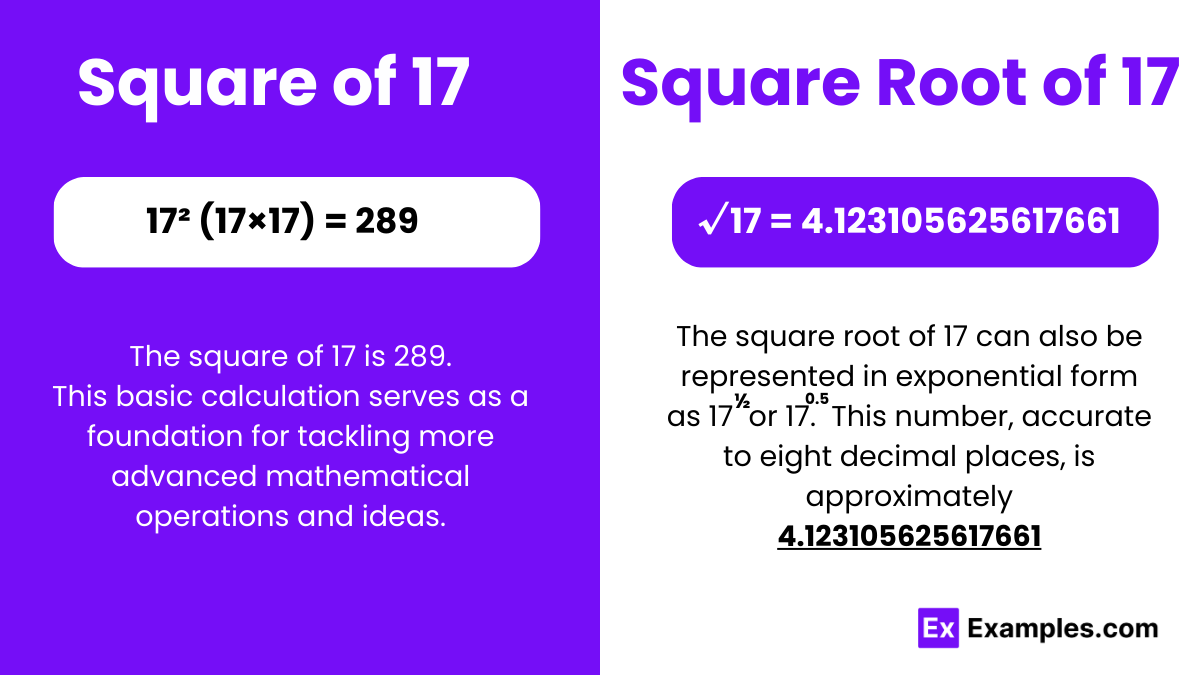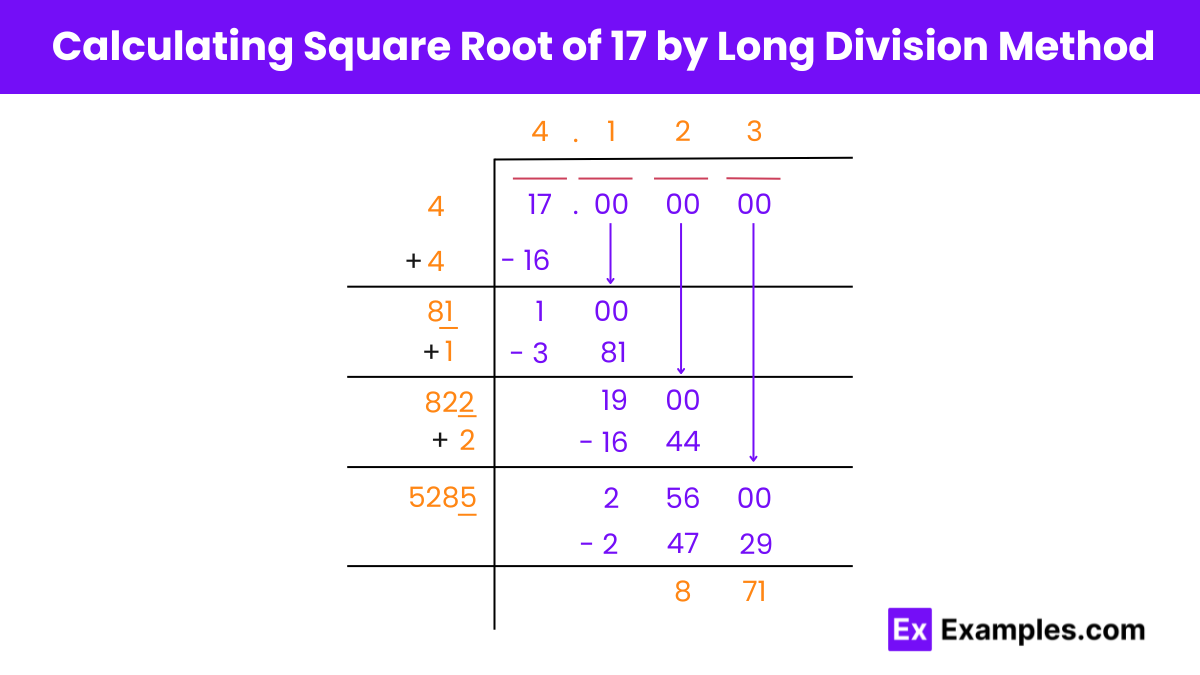What is the square of 17?
289
272
300
289

17² (17×17) = 289
The square of 17, denoted as 17^2, is the result of multiplying the number 17 by itself. In simpler terms, it’s the area of a square with side length 17 units. This mathematical operation yields the value 289. Understanding the square of 17 is fundamental in arithmetic and geometry.
or
√17=4.123 up to three places of decimal
The square root of 17, symbolized as √17, is a fundamental concept in mathematics. It represents the value that, when multiplied by itself, results in 17. In simpler terms, it’s the number which, when squared, equals 17. However, unlike whole numbers or fractions, the square root of 17 is an irrational number. This means its decimal representation goes on infinitely without repeating a pattern. When calculated, the approximate value of the square root of 17 is 4.123105625617661. Despite its seemingly random decimal expansion, the square root of 17 holds significance in various mathematical calculations, geometric problems, and real-world applications. Understanding this concept helps us comprehend the relationship between numbers, shapes, and quantities, contributing to problem-solving and analytical skills in fields such as engineering, physics, and finance.
Square Root of 17:4.123105625617661
Exponential Form:17^½ or 17^0.5
Radical Form:√17
To understand why, let’s delve into the definitions of rational and irrational numbers.
Examples of rational numbers include 1/2, -3, and 5.
Examples of irrational numbers include √2, π (pi), and √3.
Square Root of 17 as Irrational:
To understand why the square root of 17 is irrational, let’s simplify it:
√17 = √(16 + 1) = √16 * √1 = 4 * √1 = 4
Now, we know that 4 is a rational number. However, √1 is famously rational. It cannot be represented as a fraction of two integers, and its decimal form goes on forever without repeating. Therefore, 4 is also irrational because the product of a rational number (4) and an irrational number (√1) is always irrational.
In summary, the square root of 17 is irrational because it simplifies to a rational number (4), and when combined with the irrational √1, the result is always irrational.
To find the square root of 17, we can utilize various methods, including estimation, prime factorization, and using a calculator. Here’s a breakdown of a simple estimation method:

Finding the square root of 17 using the long division method involves the following steps:
Step 1: Preparation
Write 17 as 17.00 00 00, grouping digits in pairs from the decimal point. For 17, it looks like “17”.
Step 2: Find the Largest Square
Identify the largest square smaller than or equal to 17, which is 16 (4²). Place 4 above the line as the first digit of the root.
Step 3: Subtract and Bring Down
Subtract 16 from 17 to get 1, then bring down the next pair of zeros to make it 100.
Step 4: Double and Find the Next Digit
Double the current result (4) to get 8. Now, find a digit (X) such that 48 multiplied by X is less than or equal to 100. Here, X is 2, because 482×2=96.
Step 5: Repeat with Precision
Subtract 96 from 100 to get 4, bring down the next zeros to get 400, then double the quotient (42) to get 84. Choose a digit (Y) so that 84Y multiplied by Y is just under 400.
Step 6: Finish at Desired Accuracy
Continue the process until reaching the desired level of accuracy. For the square root of 17, this method gives us about 4.123 as we extend the division
A perfect square root is a number that can be expressed as the product of an integer multiplied by itself. For example, 4 (2 × 2) and 9 (3 × 3) are perfect square roots.
However, when we examine 17, we find that it cannot be expressed as the product of two identical integers. There are no integers x such that x × x equals 17.
Therefore, 17 is not a perfect square root. It doesn’t have an integer square root. While it does have a square root (√17), it’s an irrational number and not the result of multiplying any whole number by itself.
Is √17 a real number?
Yes, the square root of 17, denoted as √17, is a real number. A real number is any number that can be found on the number line, including both rational and irrational numbers. Since √17 exists on the number line and is not an imaginary number (which involve the square root of negative numbers), it is classified as a real number.
Is 17 an integer yes or no?
Yes, 17 is an integer. An integer is a whole number that can be positive, negative, or zero. Since 17 is a whole number and not a fraction or a decimal, it falls under the category of integers.
Text prompt
Add Tone
10 Examples of Public speaking
20 Examples of Gas lighting
What is the square of 17?
289
272
300
289
Which number is closest to the square root of 17?
4.1
4.2
4.3
4.4
If x² = 17, what is x?
4.1
4.2
4.3
4.4
Simplify √17 to its decimal form.
4.12
4.13
4.14
4.15
What is (17)²?
289
272
306
321
Find the approximate value of √17 to two decimal places.
4.11
4.12
4.13
4.14
What integer is closest to √17?
4
5
6
7
What is the value of 17 raised to the power of 0.5?
4.12
4.13
4.14
4.15
Calculate 17 × 17.
289
272
306
323
What is the square root of 289?
16
17
18
19
Before you leave, take our quick quiz to enhance your learning!

